Bar
An Espresso machine uses nine to ten Bars of pressure to force hot water through finely ground coffee when making espresso. A Bar is equal to 14.5 PSI, or roughly the pressure of one Atmosphere.
|
Bar System
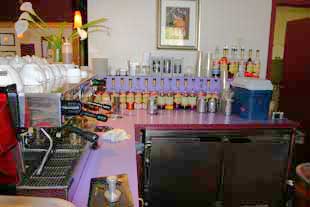 A complete espresso system, including brewer, refrigerated milk holding apparatus, coffee grinder(s), doser(s), accessories and a knock box.
|
Barista
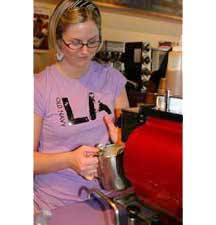 Italian for Bartender, a Barista is someone who makes coffee drinks as a profession. In Italy, a Barista typically serves both coffee and alcoholic beverages.
|
Blade Grinder
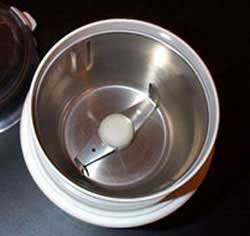 A coffee grinder that uses spinning blades to turn whole bean coffee to ground coffee. A blade grinder is simple and effective, but will produce an inconsistent particle size, or grind, compared to a bur grinder.
|
Boiler
A pressure tank used to make hot water or steam, found in most espresso brewing machines.
|
Brewing
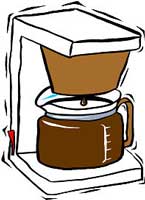 Any method of making a coffee beverage from fresh water and roasted coffee grounds.
|
Burr Grinder
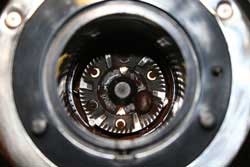 A burr grinder, or burr mill, uses rotating flat to conical metal disks with sharp ridges, or burrs, to evenly grind the coffee beans. A bur grinder is typically adjustable from very fine to coarse and produces a consistent particle size compared to the simpler blade grinder. Consistent particle size is important in brewing quality coffee, making burr grinders the choice of coffee professionals.
|
Caffeine
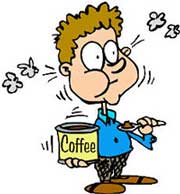 The chemical in coffee and tea that creates a stimulating effect in the human brain and nervous system. German chemist Friedrich Ferdinand Runge first isolated caffeine in 1819. The effects of caffeine in tea were known in China thousands of years before the similar effects of coffee were discovered. Caffeine is the world's most popular drug.
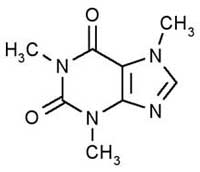
|
Crema
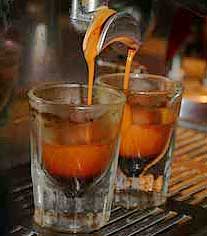 The reddish brown froth covering the surface of a high quality cup of espresso. Crema is very important in making a good espresso. The presence of crema is the main difference between drip coffee and espresso. In an espresso machine, hot pressurized water is forced through the finely ground coffee which quickly extracts the most soluble constituents. Oils in the coffee grounds form small rusty brown colored bubbles which are then forced out of the porta-filter by pressurized hot water. These small bubbles of coffee oils are what makes the crema which floats to the surface of most espresso drinks. Crema is rich with coffee flavor and can remain in the mouth and throat while releasing flavor and aroma for up to an hour after drinking espresso. There are a number of factors that affect the formation and color of crema in espresso. Coffee packed too finely in the porta-filter tends to create crema that is too dark, while coarsely ground coffee with likely produce crema that is too light. The variety of coffee, as well as the way the coffee beans were processed and then roasted, will also affect the volume and color of crema produced when making espresso.
|
Decaffeinated
Coffee with at least 97% of its original caffeine content removed. The decaffeination (decaf) process involves immersing the unroasted coffee beans in a solvent to remove the caffeine, separating the solvent from the coffee beans, and then processing the solvent to isolate the caffeine. The conventional process involves reusing the decaffeinating solvent again and again, thereby saturating the solvent with coffee flavors and preventing further transfer of flavor from the beans to the solvent. Commonly used solvents include, water (see Swiss Water Process), benzene, ethyl acetate, methylene chloride (MC), and carbon dioxide (CO2).
|
Demitasse
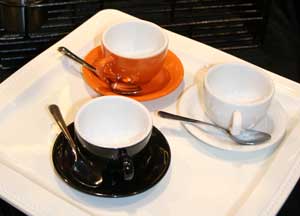 A small cup that holds about 3 to 4 ounces of liquid. Cappuccinos are traditionally served in a ceramic demitasse. Demitasse is short for "demi de tasse" which is French for "half cup".
|
Doppio
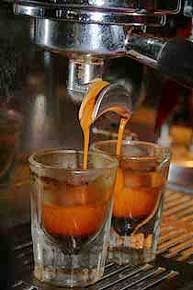 Italian for double, a "Doppio" is two full shots (approximately 3 ounces) of espresso.
|
Dose
The amount of coffee used in a serving. One shot (1.5 ounces) of espresso has about two tablespoons of coffee (about 1/4 ounces). For best flavor, one shot of espresso, or two tablespoons of coffee, should be used to make 6 ounce of coffee drink. Likewise, a 12 ounce coffee drink will taste best with two shots of espresso.
|
Doser
A spring loaded device usually attached to espresso grinders which dispenses one serving of ground coffee per pull (about 1/4 ounces). Two pulls on the doser, for example, is just enough to fill a two shot portafilter basket.
|
Doser Grinder
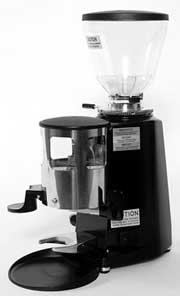 A machine that grinds the coffee beans and dispenses a measured amount of ground coffee, or dose.
|
Double
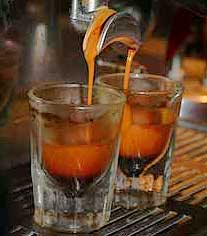 An espresso drink with two shots (three ounces) of espresso. For example, a double tall Americano has two shots of espresso mixed with hot water in a 12 ounce cup.
|
Drip Coffee
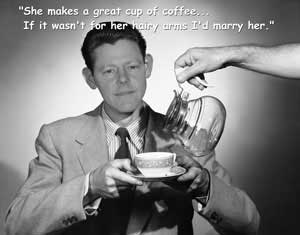 Brewed coffee made from water heated in the coffee maker and dripped through ground coffee in a filter basket directly into the cup or pot. The first automatic drip-brew coffeemaker for home use, Mr Coffee, was introduced in 1972. Many newer drip coffee machines, called "Grind and Brew" coffee makers, both grind and brew the coffee and can be set to automatically grind and brew at a specified time. Filter-drip coffee makers are the most popular type of home coffee brewers used today.
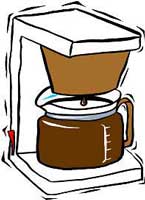
|
Drip Tray
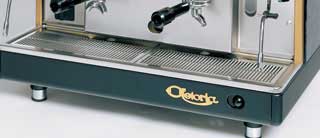 A tray under the group, or porta-filter, of an espresso machine designed to catch spillage or overflow.
|
Dry
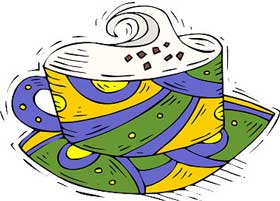 An espresso drink with frothed milk only and no hot milk. A dry cappuccino, for example, is espresso under layer of velvety milk froth.
|
Espresso
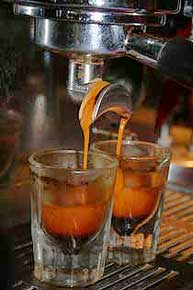 Espresso is made by forcing hot water at 9 to 10 bars of pressure through very finely ground coffee beans. The extraction of espresso happens quicker than filter-drip coffee because the more finely ground coffee has a larger wetted surface area. The high pressure hot water in an espresso machine is necessary to overcome the extra surface tension produced by the larger surface area of the finely ground coffee. What makes espresso so different than filter drip coffee is that it has crema, a reddish brown foam of coffee oils that expands as the espresso is forced through the portafilter. Crema is an important part of the flavor, beauty, and aftertaste of espresso coffee drinks. Because of the crema and quick extraction process, espresso has more flavor and less caffeine than filter-drip coffee.
|
Espresso Machine
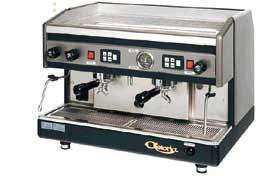 An espresso machine forces hot water at 9 to 10 bars of pressure through very finely ground coffee beans. The high pressure hot water in an espresso machine is necessary to overcome the extra surface tension produced by the large surface area of very finely ground coffee. An espresso machine makes coffee that has crema, a reddish brown foam of coffee oils formed as the espresso is forced through a portafilter. Crema is an important part of the flavor, beauty, and aftertaste or espresso coffee drinks. Because of the crema production, and quick extraction process, espresso machines make coffee with more flavor and less caffeine compared to filter-drip machines.
|
Espresso Pod
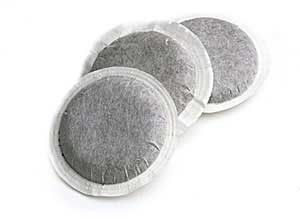 Ground espresso coffee compressed and wrapped in a filter used to make a single serving of espresso. Special pod machines are used to make coffee from espresso pods. An obvious advantage of using espresso pods is the lack of coffee grounds to clean up. A disadvantage is that pods use already ground coffee which stales quicker than whole bean coffee.
|
Espresso Romano
Italian for espresso with a squeeze of lemon
|
Filter Basket
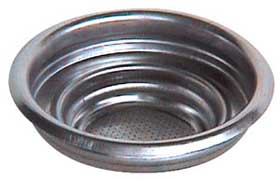 The perforated, usually stainless steel, receptacle used to hold the coffee grounds when brewing coffee. The filter basket for an espresso machine fits inside a portafilter that clamps to the machine. Espresso machines typically utilize two filter baskets, one for brewing single servings and one for brewing double servings.
|
French Press
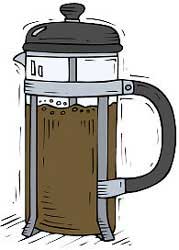 The French Press, or Cafetiere (French for "coffee pot"), was invented in France in the mid 1800s. Despite the name, most coffee in France is brewed by the drip method. To use a French Press, remove the filter-plunger top and place coarsely ground coffee into the bottom of the press. Using a fine grind with a French Press will result in coffee that's gritty and bitter. After letting the coffee steep for several minutes, serve immediately, or place into a different container to keep hot. Since the coffee is fully immersed in the French Press, the level of extraction is high. Leaving coffee in the press for more than 5 minutes will over extract the grounds and the coffee will become bitter. A French Press is also called a "plunger pot".
|
Freshness
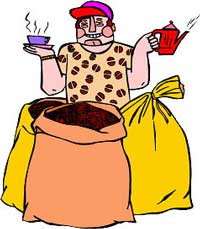 Coffee Freshness is lost over time, at a rate that depends on how it is stored. Unroasted, green, or raw, coffee can stay fresh for years. Roasted whole bean coffee can remain fresh for months if kept in an airtight container in a freezer, for weeks in airtight container at room temperature, and for days exposed to air at room temperature. Ground coffee will stay fresh for several hours, after which the flavor fades quickly. Good coffee flavor is largely dependent on the brewing process, coffee bean quality, and freshness.
|
Frothing
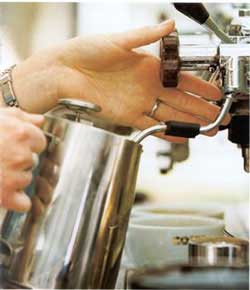 The process of making froth, or velvety hot foam, from milk using the steam wand of an espresso machine. A Barista skillfully uses the steam wand to draw air into the milk until the mixture reaches 155 to 165 degrees Fahrenheit and the foam becomes thick and velvety.
|
Gicleur
A small orifice used in espresso machines to limit the flow of hot water through the group. The term gigleur is an Italian derivation of gicleur, which is French for "jet" and derived from the French verb gicler (to squirt). The gigleur prevents too much water from flowing through the group when the portafilter is removed.
|
Gourmet Coffee
Sometimes called "specialty" or "premium" coffee, gourmet coffees are made from exceptional Arabica beans grown in ideal coffee-producing climates, and usually harvested by hand in mountainous areas. Gourmet coffees have distinctive flavors, specific to botanical variety, processing method, and the unique characteristics of the soil and environment that produces them. Gourmet coffees stand in stark contrast to the often bitter Robusta beans grown at low elevations and harvested by machine.
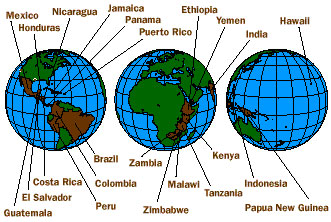
|
Grande
Italian for "large", a Grande is a 16 oz coffee drink. A 16 ounce Mocha, for example, is called a Grande Mocha. Coffee drink sizes from smallest to largest are: Short (8 oz), Tall (12oz), Grande (16 oz), and Vente (20oz).
|
Grind
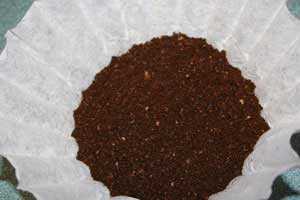 The particle size of ground coffee. The recommended grind depends on brewing method. The grind should be adjusted to create the desired amount of coffee extraction. The finer the grind, the quicker coffee can be extracted. Too much coffee extraction will remove unwanted chemicals and make the coffee taste bitter, while too little extraction will cause the coffee to taste flat and watery. Finely ground coffee has more surface area than coarsely ground coffee which allows for quick extraction, but the increased surface tension will not allow water to pass through the grounds by gravity. Espresso machines force hot water through very finely ground coffee at eight to ten times atmospheric pressure (8 to 10 Bars) to quickly make coffee that is neither under-extracted or over-extracted. Experience has found that with an espresso machine, optimum flavor is achieved by adjusting the grind so that a 1.5 ounce shot glass fills in about 25 seconds. A medium grind is used for filter-drip coffee machines and a course grind is used for brewing with a French Press. The finest of all grinds is the powdery Turkish Grind, used to make Turkish Coffee.
|
Group
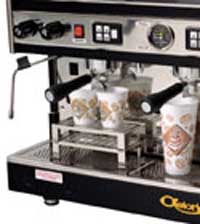 A cylindrical receptacle on a traditional espresso machine into which the portafilter clamps.
|
Half Caf
A coffee drink with half the caffeine, made by blending equal parts of decaffeinated and "regular" coffees. Also called "half and half" or "split shot".
|
Harmless
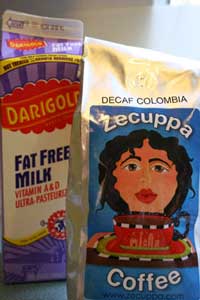 A non-fat, decaffeinated coffee drink.
|
Iced Latte
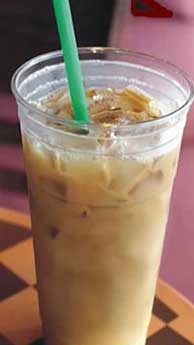 Latte served cold with ice. To make an Iced Latte, place ice in glass, add milk, then pour espresso and mix over the ice.
|
Knock Box
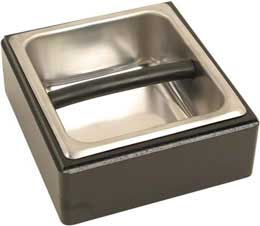 A small stainless steel pan or drawer under or near the espresso machine of a bar counter for disposal of spent coffee grounds. It's called a knock box because the barista knocks the portafilter to remove the grounds.
|
Latte Art
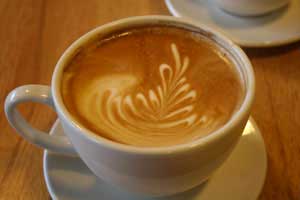 Creative designs made on the surface of an espresso drink. Latte art may be made by skillfully pouring milk through espresso, or with the aid of toothpicks, chocolate syrup, or sprinkles.
Video
|
No Fun
A decaf coffee, or latte.
|
Piston Espresso Machine
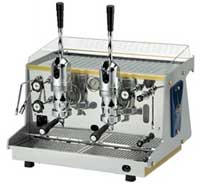 An espresso brewing device in which the required water pressure for espresso brewing is provided by a piston attached to a manually operated lever.
|
Porta-Filter
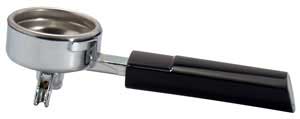 A removable device, usually with a plastic handle, that contains a metal coffee filter and clamps onto the group of an espresso machine. A bottomless, or naked, portafilter is similar to a regular portafilter but with the bottom removed to expose the screened basket.
|
Pulled Long
An espresso "pulled long" is a serving of espresso extracted longer than the normal 20 to 30 second shot, and with more volume than the normal 1.5 ounce shot. A shot pulled long extracts more caffeine and more bitter flavors. Also called Espresso Lungo.
|
Pulled Short
An espresso "pulled short" is a serving of espresso extracted shorter than the normal 20 to 30 second shot, and with less volume than the normal 1.5 ounce shot. Espresso pulled short is more concentrated, less bitter, and has less caffeine than a normal espresso shot, but will make a slightly less flavorful coffee drink when compared with a similar drink made with a normal 1.5 ounce shot of espresso. Also called "espresso ristretto" which is Italian for "espresso narrowed or shrunk"
|
Quad
An espresso drink with four shots of coffee.
|
Shot
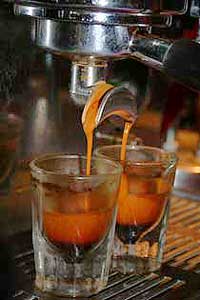 A coffee shot, or serving, is 1.5 ounces of espresso. Shots pulled short are less than 1.5 ounces. Shots pulled long are more than 1.5 ounces.
|
Skinny
Any espresso drink made with non-fat milk. For example, a skinny Latte is a Latte made with non-fat milk.
|
Solo
A coffee drink with a single shot (approximately 1.5 ounces) of espresso. For example, a solo tall mocha is a 12 ounce mocha with one shot of espresso.
|
Steam Wand
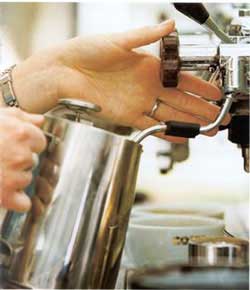 A pipe stem on most espresso machines used to provide steam for frothing milk.
|
Steaming Pitcher
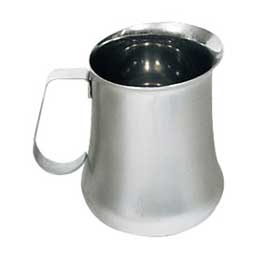 A stainless steel container used in conjunction with the steam wand of an espresso machine to make frothed milk.
|
Tall
A 12 ounce coffee beverage. For example, a double tall Mocha is a mocha with two shots of espresso in a 12 ounce cup. Sizes are short (8 oz), tall (12 oz), grande (16 oz), and vente (20 oz).
|
Tamper
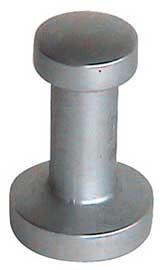 A device used to compress coffee inside a filter basket before beginning the brewing operation. Tampers are often hand held accessories or attached to espresso grinders. Attached tampers allow baristas to handle the tamping operation with one handed flair.
|
Tamping
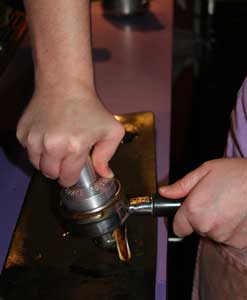 Tamping finely ground espresso beans is necessary to produce consistent espresso and prevent channeling of the brewing water through the portafilter. Proper tamping requires a consistent force of up to about thirty pounds.
|
Turkish Coffee
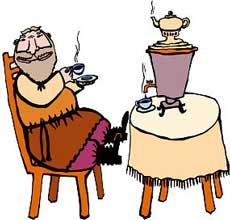 Coffee ground to a fine powder, brewed by mixing with hot water, and served with the grounds. Preparing turkish coffee requires some expertise, partly because finely ground coffee does not mix readily with water,
|
Valve Bag
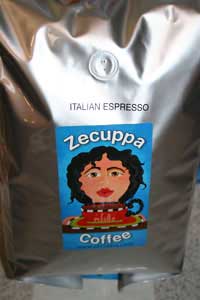 Valve bags are air tight coffee bags with small one-way valves that allow gases escape but do not allow air into the bag. The valve bag was a significant development for the specialty coffee industry since it allowed coffee roasters to package freshly roasted coffee without first degassing the coffee beans. Shortly after roasting, coffee beans give off a tremendous amount of gas, which will expand sealed packages not equipped with a one-way valve. If packaged immediately in valve bag, freshly roasted coffee will produce enough gas to expel most of the oxygen from the bag, thereby allowing the beans to stay fresh much longer. Storing coffee beans: If you grind your fresh roasted beans within a week or two, an airtight container in a cool dark place is ideal. If you have a large quantity of fresh coffee in unopened foil valve bags, the entire air-tight valve bags can be stored in a freezer to retain freshness for months. For best results, thaw before opening to prevent water from condensing on the beans. Refreezing coffee beans is not recommended.
|
Vente
A 20 ounce coffee beverage. For example, a triple vente Mocha is a 20 ounce mocha with three shots (4.5 ounces) of espresso.
|
Water Purification
Most coffee brewing systems benefit from water purification. Water purification generally improves the taste, odor and appearance of the supply water and in turn improves the coffee taste. Effective filters remove contaminates, excess chlorine, particulate matter and other impurities. Good filtering systems are inexpensive and readily available; most on the market range from a single, butted type cartridge, to a three-cartridge set-up, usually mounted on a wall under or near the brewer or espresso machine. The placement of a filtering system should be strategic, making sure that (1) water is filtered before its introduction to the brewer or espresso machine, and (2) water filters are easily accessible for routine changing (the frequency of which is determined by the particular system and volume of machine use. Water softening is generally required to prevent accumulation of minerals in espresso machine boilers.
|
Water Softening
In most areas, to prevent espresso machine maintenance problems, water treatment beyond filtration is needed to remove dissolved calcium and magnesium. Dissolved minerals, mainly calcium and magnesium, will eventually form solid deposits, or scale, when water is boiled. This scale can clog and damage an espresso machine. Unless the water supply is very soft, softening is recommended to help protect espresso machines from internal damage.
|
Wet
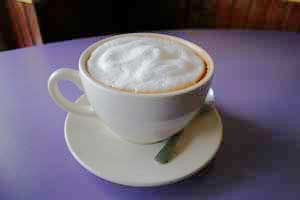 Some coffee drinks, such as Cappuccinos may be ordered dry, meaning with milk froth only and no steamed milk. A wet Cappuccino is a regular Cappuccino, including the 1/3 steamed milk.
|
Whole Bean
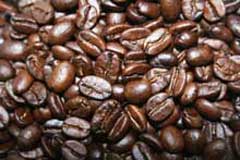 Unground roasted coffee beans. Whole bean coffee has the advantage of staying fresh much longer than ground coffee. Also, whole beans can be ground to different sizes for different machines and for optimum flavor.
|
With Legs
 A coffee order "to-go". For example, a Latte with legs, is a Latte served in a disposable insulated cup with lid ready to go.
|
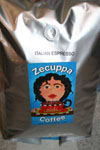

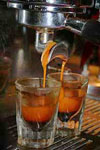
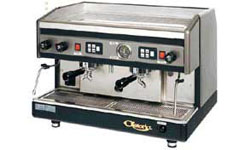


 A complete espresso system, including brewer, refrigerated milk holding apparatus, coffee grinder(s), doser(s), accessories and a knock box.
A complete espresso system, including brewer, refrigerated milk holding apparatus, coffee grinder(s), doser(s), accessories and a knock box.
 Italian for Bartender, a Barista is someone who makes coffee drinks as a profession. In Italy, a Barista typically serves both coffee and alcoholic beverages.
Italian for Bartender, a Barista is someone who makes coffee drinks as a profession. In Italy, a Barista typically serves both coffee and alcoholic beverages.
 A coffee grinder that uses spinning blades to turn whole bean coffee to ground coffee. A blade grinder is simple and effective, but will produce an inconsistent particle size, or grind, compared to a bur grinder.
A coffee grinder that uses spinning blades to turn whole bean coffee to ground coffee. A blade grinder is simple and effective, but will produce an inconsistent particle size, or grind, compared to a bur grinder.
 Any method of making a coffee beverage from fresh water and roasted coffee grounds.
Any method of making a coffee beverage from fresh water and roasted coffee grounds.
 A burr grinder, or burr mill, uses rotating flat to conical metal disks with sharp ridges, or burrs, to evenly grind the coffee beans. A bur grinder is typically adjustable from very fine to coarse and produces a consistent particle size compared to the simpler blade grinder. Consistent particle size is important in brewing quality coffee, making burr grinders the choice of coffee professionals.
A burr grinder, or burr mill, uses rotating flat to conical metal disks with sharp ridges, or burrs, to evenly grind the coffee beans. A bur grinder is typically adjustable from very fine to coarse and produces a consistent particle size compared to the simpler blade grinder. Consistent particle size is important in brewing quality coffee, making burr grinders the choice of coffee professionals.
 The chemical in coffee and tea that creates a stimulating effect in the human brain and nervous system. German chemist Friedrich Ferdinand Runge first isolated caffeine in 1819. The effects of caffeine in tea were known in China thousands of years before the similar effects of coffee were discovered. Caffeine is the world's most popular drug.
The chemical in coffee and tea that creates a stimulating effect in the human brain and nervous system. German chemist Friedrich Ferdinand Runge first isolated caffeine in 1819. The effects of caffeine in tea were known in China thousands of years before the similar effects of coffee were discovered. Caffeine is the world's most popular drug.

 The reddish brown froth covering the surface of a high quality cup of espresso. Crema is very important in making a good espresso. The presence of crema is the main difference between drip coffee and espresso. In an espresso machine, hot pressurized water is forced through the finely ground coffee which quickly extracts the most soluble constituents. Oils in the coffee grounds form small rusty brown colored bubbles which are then forced out of the porta-filter by pressurized hot water. These small bubbles of coffee oils are what makes the crema which floats to the surface of most espresso drinks. Crema is rich with coffee flavor and can remain in the mouth and throat while releasing flavor and aroma for up to an hour after drinking espresso. There are a number of factors that affect the formation and color of crema in espresso. Coffee packed too finely in the porta-filter tends to create crema that is too dark, while coarsely ground coffee with likely produce crema that is too light. The variety of coffee, as well as the way the coffee beans were processed and then roasted, will also affect the volume and color of crema produced when making espresso.
The reddish brown froth covering the surface of a high quality cup of espresso. Crema is very important in making a good espresso. The presence of crema is the main difference between drip coffee and espresso. In an espresso machine, hot pressurized water is forced through the finely ground coffee which quickly extracts the most soluble constituents. Oils in the coffee grounds form small rusty brown colored bubbles which are then forced out of the porta-filter by pressurized hot water. These small bubbles of coffee oils are what makes the crema which floats to the surface of most espresso drinks. Crema is rich with coffee flavor and can remain in the mouth and throat while releasing flavor and aroma for up to an hour after drinking espresso. There are a number of factors that affect the formation and color of crema in espresso. Coffee packed too finely in the porta-filter tends to create crema that is too dark, while coarsely ground coffee with likely produce crema that is too light. The variety of coffee, as well as the way the coffee beans were processed and then roasted, will also affect the volume and color of crema produced when making espresso.
 A small cup that holds about 3 to 4 ounces of liquid. Cappuccinos are traditionally served in a ceramic demitasse. Demitasse is short for "demi de tasse" which is French for "half cup".
A small cup that holds about 3 to 4 ounces of liquid. Cappuccinos are traditionally served in a ceramic demitasse. Demitasse is short for "demi de tasse" which is French for "half cup".
 Italian for double, a "Doppio" is two full shots (approximately 3 ounces) of espresso.
Italian for double, a "Doppio" is two full shots (approximately 3 ounces) of espresso.
 A machine that grinds the coffee beans and dispenses a measured amount of ground coffee, or dose.
A machine that grinds the coffee beans and dispenses a measured amount of ground coffee, or dose.
 An espresso drink with two shots (three ounces) of espresso. For example, a double tall Americano has two shots of espresso mixed with hot water in a 12 ounce cup.
An espresso drink with two shots (three ounces) of espresso. For example, a double tall Americano has two shots of espresso mixed with hot water in a 12 ounce cup.
 Brewed coffee made from water heated in the coffee maker and dripped through ground coffee in a filter basket directly into the cup or pot. The first automatic drip-brew coffeemaker for home use, Mr Coffee, was introduced in 1972. Many newer drip coffee machines, called "Grind and Brew" coffee makers, both grind and brew the coffee and can be set to automatically grind and brew at a specified time. Filter-drip coffee makers are the most popular type of home coffee brewers used today.
Brewed coffee made from water heated in the coffee maker and dripped through ground coffee in a filter basket directly into the cup or pot. The first automatic drip-brew coffeemaker for home use, Mr Coffee, was introduced in 1972. Many newer drip coffee machines, called "Grind and Brew" coffee makers, both grind and brew the coffee and can be set to automatically grind and brew at a specified time. Filter-drip coffee makers are the most popular type of home coffee brewers used today.

 A tray under the group, or porta-filter, of an espresso machine designed to catch spillage or overflow.
A tray under the group, or porta-filter, of an espresso machine designed to catch spillage or overflow.
 An espresso drink with frothed milk only and no hot milk. A dry cappuccino, for example, is espresso under layer of velvety milk froth.
An espresso drink with frothed milk only and no hot milk. A dry cappuccino, for example, is espresso under layer of velvety milk froth.
 Espresso is made by forcing hot water at 9 to 10 bars of pressure through very finely ground coffee beans. The extraction of espresso happens quicker than filter-drip coffee because the more finely ground coffee has a larger wetted surface area. The high pressure hot water in an espresso machine is necessary to overcome the extra surface tension produced by the larger surface area of the finely ground coffee. What makes espresso so different than filter drip coffee is that it has crema, a reddish brown foam of coffee oils that expands as the espresso is forced through the portafilter. Crema is an important part of the flavor, beauty, and aftertaste of espresso coffee drinks. Because of the crema and quick extraction process,
Espresso is made by forcing hot water at 9 to 10 bars of pressure through very finely ground coffee beans. The extraction of espresso happens quicker than filter-drip coffee because the more finely ground coffee has a larger wetted surface area. The high pressure hot water in an espresso machine is necessary to overcome the extra surface tension produced by the larger surface area of the finely ground coffee. What makes espresso so different than filter drip coffee is that it has crema, a reddish brown foam of coffee oils that expands as the espresso is forced through the portafilter. Crema is an important part of the flavor, beauty, and aftertaste of espresso coffee drinks. Because of the crema and quick extraction process,  An espresso machine forces hot water at 9 to 10 bars of pressure through very finely ground coffee beans. The high pressure hot water in an espresso machine is necessary to overcome the extra surface tension produced by the large surface area of very finely ground coffee. An espresso machine makes coffee that has crema, a reddish brown foam of coffee oils formed as the espresso is forced through a portafilter. Crema is an important part of the flavor, beauty, and aftertaste or espresso coffee drinks. Because of the crema production, and quick extraction process, espresso machines make coffee with more flavor and less caffeine compared to filter-drip machines.
An espresso machine forces hot water at 9 to 10 bars of pressure through very finely ground coffee beans. The high pressure hot water in an espresso machine is necessary to overcome the extra surface tension produced by the large surface area of very finely ground coffee. An espresso machine makes coffee that has crema, a reddish brown foam of coffee oils formed as the espresso is forced through a portafilter. Crema is an important part of the flavor, beauty, and aftertaste or espresso coffee drinks. Because of the crema production, and quick extraction process, espresso machines make coffee with more flavor and less caffeine compared to filter-drip machines.
 Ground espresso coffee compressed and wrapped in a filter used to make a single serving of espresso. Special pod machines are used to make coffee from espresso pods. An obvious advantage of using espresso pods is the lack of coffee grounds to clean up. A disadvantage is that pods use already ground coffee which stales quicker than whole bean coffee.
Ground espresso coffee compressed and wrapped in a filter used to make a single serving of espresso. Special pod machines are used to make coffee from espresso pods. An obvious advantage of using espresso pods is the lack of coffee grounds to clean up. A disadvantage is that pods use already ground coffee which stales quicker than whole bean coffee.
 The perforated, usually stainless steel, receptacle used to hold the coffee grounds when brewing coffee. The filter basket for an espresso machine fits inside a portafilter that clamps to the machine. Espresso machines typically utilize two filter baskets, one for brewing single servings and one for brewing double servings.
The perforated, usually stainless steel, receptacle used to hold the coffee grounds when brewing coffee. The filter basket for an espresso machine fits inside a portafilter that clamps to the machine. Espresso machines typically utilize two filter baskets, one for brewing single servings and one for brewing double servings.
 The French Press, or Cafetiere (French for "coffee pot"), was invented in France in the mid 1800s. Despite the name, most coffee in France is brewed by the drip method. To use a French Press, remove the filter-plunger top and place coarsely ground coffee into the bottom of the press. Using a fine grind with a French Press will result in coffee that's gritty and bitter. After letting the coffee steep for several minutes, serve immediately, or place into a different container to keep hot. Since the coffee is fully immersed in the French Press, the level of extraction is high. Leaving coffee in the press for more than 5 minutes will over extract the grounds and the coffee will become bitter. A French Press is also called a "plunger pot".
The French Press, or Cafetiere (French for "coffee pot"), was invented in France in the mid 1800s. Despite the name, most coffee in France is brewed by the drip method. To use a French Press, remove the filter-plunger top and place coarsely ground coffee into the bottom of the press. Using a fine grind with a French Press will result in coffee that's gritty and bitter. After letting the coffee steep for several minutes, serve immediately, or place into a different container to keep hot. Since the coffee is fully immersed in the French Press, the level of extraction is high. Leaving coffee in the press for more than 5 minutes will over extract the grounds and the coffee will become bitter. A French Press is also called a "plunger pot".
 Coffee Freshness is lost over time, at a rate that depends on how it is stored. Unroasted, green, or raw, coffee can stay fresh for years. Roasted whole bean coffee can remain fresh for months if kept in an airtight container in a freezer, for weeks in airtight container at room temperature, and for days exposed to air at room temperature. Ground coffee will stay fresh for several hours, after which the flavor fades quickly. Good coffee flavor is largely dependent on the brewing process, coffee bean quality, and freshness.
Coffee Freshness is lost over time, at a rate that depends on how it is stored. Unroasted, green, or raw, coffee can stay fresh for years. Roasted whole bean coffee can remain fresh for months if kept in an airtight container in a freezer, for weeks in airtight container at room temperature, and for days exposed to air at room temperature. Ground coffee will stay fresh for several hours, after which the flavor fades quickly. Good coffee flavor is largely dependent on the brewing process, coffee bean quality, and freshness.
 The process of making froth, or velvety hot foam, from milk using the steam wand of an espresso machine. A Barista skillfully uses the steam wand to draw air into the milk until the mixture reaches 155 to 165 degrees Fahrenheit and the foam becomes thick and velvety.
The process of making froth, or velvety hot foam, from milk using the steam wand of an espresso machine. A Barista skillfully uses the steam wand to draw air into the milk until the mixture reaches 155 to 165 degrees Fahrenheit and the foam becomes thick and velvety.

 The particle size of ground coffee. The recommended grind depends on brewing method. The grind should be adjusted to create the desired amount of coffee extraction. The finer the grind, the quicker coffee can be extracted. Too much coffee extraction will remove unwanted chemicals and make the coffee taste bitter, while too little extraction will cause the coffee to taste flat and watery. Finely ground coffee has more surface area than coarsely ground coffee which allows for quick extraction, but the increased surface tension will not allow water to pass through the grounds by gravity. Espresso machines force hot water through very finely ground coffee at eight to ten times atmospheric pressure (8 to 10 Bars) to quickly make coffee that is neither under-extracted or over-extracted. Experience has found that with an espresso machine, optimum flavor is achieved by adjusting the grind so that a 1.5 ounce shot glass fills in about 25 seconds. A medium grind is used for filter-drip coffee machines and a course grind is used for brewing with a French Press. The finest of all grinds is the powdery Turkish Grind, used to make Turkish Coffee.
The particle size of ground coffee. The recommended grind depends on brewing method. The grind should be adjusted to create the desired amount of coffee extraction. The finer the grind, the quicker coffee can be extracted. Too much coffee extraction will remove unwanted chemicals and make the coffee taste bitter, while too little extraction will cause the coffee to taste flat and watery. Finely ground coffee has more surface area than coarsely ground coffee which allows for quick extraction, but the increased surface tension will not allow water to pass through the grounds by gravity. Espresso machines force hot water through very finely ground coffee at eight to ten times atmospheric pressure (8 to 10 Bars) to quickly make coffee that is neither under-extracted or over-extracted. Experience has found that with an espresso machine, optimum flavor is achieved by adjusting the grind so that a 1.5 ounce shot glass fills in about 25 seconds. A medium grind is used for filter-drip coffee machines and a course grind is used for brewing with a French Press. The finest of all grinds is the powdery Turkish Grind, used to make Turkish Coffee.
 A cylindrical receptacle on a traditional espresso machine into which the portafilter clamps.
A cylindrical receptacle on a traditional espresso machine into which the portafilter clamps.
 A non-fat, decaffeinated coffee drink.
A non-fat, decaffeinated coffee drink.
 Latte served cold with ice. To make an Iced Latte, place ice in glass, add milk, then pour espresso and mix over the ice.
Latte served cold with ice. To make an Iced Latte, place ice in glass, add milk, then pour espresso and mix over the ice.
 A small stainless steel pan or drawer under or near the espresso machine of a bar counter for disposal of spent coffee grounds. It's called a knock box because the barista knocks the portafilter to remove the grounds.
A small stainless steel pan or drawer under or near the espresso machine of a bar counter for disposal of spent coffee grounds. It's called a knock box because the barista knocks the portafilter to remove the grounds.
 Creative designs made on the surface of an espresso drink. Latte art may be made by skillfully pouring milk through espresso, or with the aid of toothpicks, chocolate syrup, or sprinkles.
Creative designs made on the surface of an espresso drink. Latte art may be made by skillfully pouring milk through espresso, or with the aid of toothpicks, chocolate syrup, or sprinkles.
 An espresso brewing device in which the required water pressure for espresso brewing is provided by a piston attached to a manually operated lever.
An espresso brewing device in which the required water pressure for espresso brewing is provided by a piston attached to a manually operated lever.
 A removable device, usually with a plastic handle, that contains a metal coffee filter and clamps onto the group of an espresso machine. A bottomless, or naked, portafilter is similar to a regular portafilter but with the bottom removed to expose the screened basket.
A removable device, usually with a plastic handle, that contains a metal coffee filter and clamps onto the group of an espresso machine. A bottomless, or naked, portafilter is similar to a regular portafilter but with the bottom removed to expose the screened basket.
 A coffee shot, or serving, is 1.5 ounces of espresso. Shots pulled short are less than 1.5 ounces. Shots pulled long are more than 1.5 ounces.
A coffee shot, or serving, is 1.5 ounces of espresso. Shots pulled short are less than 1.5 ounces. Shots pulled long are more than 1.5 ounces.
 A pipe stem on most espresso machines used to provide steam for frothing milk.
A pipe stem on most espresso machines used to provide steam for frothing milk.
 A stainless steel container used in conjunction with the steam wand of an espresso machine to make frothed milk.
A stainless steel container used in conjunction with the steam wand of an espresso machine to make frothed milk.
 A device used to compress coffee inside a filter basket before beginning the brewing operation. Tampers are often hand held accessories or attached to espresso grinders. Attached tampers allow baristas to handle the tamping operation with one handed flair.
A device used to compress coffee inside a filter basket before beginning the brewing operation. Tampers are often hand held accessories or attached to espresso grinders. Attached tampers allow baristas to handle the tamping operation with one handed flair.
 Tamping finely ground espresso beans is necessary to produce consistent espresso and prevent channeling of the brewing water through the portafilter. Proper tamping requires a consistent force of up to about thirty pounds.
Tamping finely ground espresso beans is necessary to produce consistent espresso and prevent channeling of the brewing water through the portafilter. Proper tamping requires a consistent force of up to about thirty pounds.
 Coffee ground to a fine powder, brewed by mixing with hot water, and served with the grounds. Preparing turkish coffee requires some expertise, partly because finely ground coffee does not mix readily with water,
Coffee ground to a fine powder, brewed by mixing with hot water, and served with the grounds. Preparing turkish coffee requires some expertise, partly because finely ground coffee does not mix readily with water,
 Valve bags are air tight coffee bags with small one-way valves that allow gases escape but do not allow air into the bag. The valve bag was a significant development for the specialty coffee industry since it allowed coffee roasters to package freshly roasted coffee without first degassing the coffee beans. Shortly after roasting, coffee beans give off a tremendous amount of gas, which will expand sealed packages not equipped with a one-way valve. If packaged immediately in valve bag, freshly roasted coffee will produce enough gas to expel most of the oxygen from the bag, thereby allowing the beans to stay fresh much longer.
Valve bags are air tight coffee bags with small one-way valves that allow gases escape but do not allow air into the bag. The valve bag was a significant development for the specialty coffee industry since it allowed coffee roasters to package freshly roasted coffee without first degassing the coffee beans. Shortly after roasting, coffee beans give off a tremendous amount of gas, which will expand sealed packages not equipped with a one-way valve. If packaged immediately in valve bag, freshly roasted coffee will produce enough gas to expel most of the oxygen from the bag, thereby allowing the beans to stay fresh much longer.  Some coffee drinks, such as Cappuccinos may be ordered dry, meaning with milk froth only and no steamed milk. A wet Cappuccino is a regular Cappuccino, including the 1/3 steamed milk.
Some coffee drinks, such as Cappuccinos may be ordered dry, meaning with milk froth only and no steamed milk. A wet Cappuccino is a regular Cappuccino, including the 1/3 steamed milk.
 Unground roasted coffee beans. Whole bean coffee has the advantage of staying fresh much longer than ground coffee. Also, whole beans can be ground to different sizes for different machines and for optimum flavor.
Unground roasted coffee beans. Whole bean coffee has the advantage of staying fresh much longer than ground coffee. Also, whole beans can be ground to different sizes for different machines and for optimum flavor.
 A coffee order "to-go". For example, a Latte with legs, is a Latte served in a disposable insulated cup with lid ready to go.
A coffee order "to-go". For example, a Latte with legs, is a Latte served in a disposable insulated cup with lid ready to go.